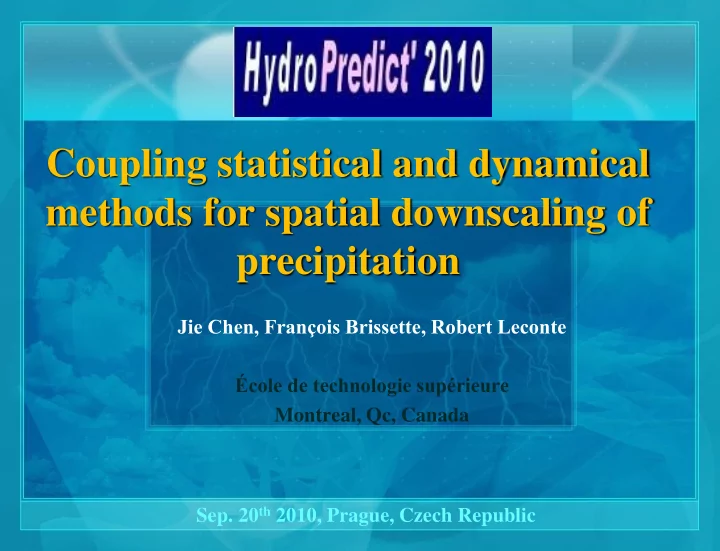

Coupling statistical and dynamical methods for spatial downscaling of precipitation Jie Chen, François Brissette, Robert Leconte École de technologie supérieure Montreal, Qc, Canada Sep. 20 th 2010, Prague, Czech Republic
1. Background (1) The Intergovernmental Panel on Climate Change (IPCC) stated that the yearly mean precipitation is very likely to increase in Canada with increases predicted in winter and spring combined with decreases in summer (IPCC, 2007). General Circulation Models (GCMs) have been developed to simulate the present climate and predict future climate change. Sep. 20 th 2010, Prague, Czech Republic
1. Background (2) Impact models require ... 150km 50km 10km 1m General Circulation Models supply... Point Sep. 20 th 2010, Prague, Czech Republic
1. Background (3) Hence, downscaling techniques have been developed to address this scale problem : Regional Climate Models (RCMs) - “dynamical downscaling” Empirical/Statistical Models - “statistical downscaling (SD)” Transfer function (TF) Weather typing (WT) Weather generator (WG) Sep. 20 th 2010, Prague, Czech Republic
2. Objectives Downscaling 1 2 Assess the efficiency Assess the of a weather typing improvement in SD approach in using RCM variables downscaling as predictors over precipitation; GCM; Sep. 20 th 2010, Prague, Czech Republic
3. Methodologies Downscaling Precip Precip occurr amount 1. Transfer 2. 1. Transfer 2. Weather function Discriminant function typing approach approach approach Analysis (SDSM- (DA) (SDSM- (WT) like) like) Sep. 20 th 2010, Prague, Czech Republic
3.1 Precipitation Occurrence SDSM-like Wet Wet? Random number TF Predictors Present P wet Predictors Future P wet ? Discriminant Analysis (DA) Wet Wet? Rules Training sample New sample Dry Dry? Sep. 20 th 2010, Prague, Czech Republic
3.2 Precipitation amount Screen Model Screen Model calibration calibration variables variables A B B C A Synoptic SDSM Weather classification -like typing Scenario Model Scenario Model c D D E validation validation generation generation Sep. 20 th 2010, Prague, Czech Republic
3.3 Validation Three Stations: Svir219, Svir293, Svir689 Time periods: 1970-1984 (Calibration); 1985-1999 (Validation) Diagnostics: 1. Frequency distribution of dry and wet periods; 2. Successful rates of identified wet and dry days; 3. Mean and standard deviation of daily precipitation; 4. Explained variance Sep. 20 th 2010, Prague, Czech Republic
4. Results (1) Sep. 20 th 2010, Prague, Czech Republic
4. Results (2) SDSM Discriminant Analysis Station Source NCEP_ CRCM_ NCEP_ CRCM_ variable variable variable variable Total days 5475 obs_wet_day 2400 pre_wet_day 2320 2356 2347 2340 Svir219 cor_wet_day 42.8% 43.8% 66.3% 72.0% cor_dry_day 58.0% 56.1% 75.4% 80.1% obs_wet_day 2452 pre_wet_day 2379 2435 2432 2362 Svir293 cor_wet_day 43.6% 45.1% 68.5% 74.8% cor_dry_day 56.6% 56.0% 75.1% 82.5% obs_wet_day 1818 pre_wet_day 1824 1757 2248 1926 Svir689 cor_wet_day 33.3% 32.4% 70.1% 71.9% cor_dry_day 66.7% 28.1% 73.4% 83.1% Sep. 20 th 2010, Prague, Czech Republic
4. Results (3) Mean Standard deviation Station Season Observed SDSM_ SDSM_ WT_ Observed SDSM_ SDSM_ WT_ NCEP CRCM CRCM NCEP CRCM CRCM Spring 4.2 2.8 3.4 3.4 4.7 2.0 3.7 3.5 Summer 5.7 3.6 3.8 3.7 6.6 2.3 3.0 3.1 Sivr219 Autumn 4.6 3.0 3.6 3.6 6.0 2.4 4.5 4.6 Winter 3.3 2.2 2.7 2.7 4.0 1.4 3.4 3.5 Spring 3.5 2.7 3.0 3.0 4.7 2.3 3.8 3.5 Summer 5.0 3.5 3.5 3.5 6.3 2.5 2.8 3.0 Svir293 Autumn 4.4 3.1 3.5 3.5 6.1 2.9 4.3 4.3 Winter 2.8 2.1 2.4 2.5 3.5 1.5 3.5 3.4 Spring 4.9 3.1 3.5 3.5 5.7 1.8 3.7 3.7 Summer 6.1 3.5 3.6 3.4 8.1 1.6 2.2 2.0 Svir689 Autumn 5.2 3.5 3.9 3.9 7.0 2.4 4.4 4.6 Winter 3.6 2.6 2.8 2.8 4.6 2.1 3.5 3.6 MRE(%) -- -32.3 -24.0 -24.0 -- -61.5 -32.4 -32.3 Sep. 20 th 2010, Prague, Czech Republic
4. Results (4) Explained variance (%) of Explained variance (%) of calibration validation Station Season SDSM_ SDSM_ WT SDSM_ SDSM_ WT_ NCEP CRCM CRCM NCEP CRCM CRCM Spring 21.8 45.3 45.6 15.7 31.3 31.8 Summer 18.7 30.8 31.8 12.3 17.1 15.0 Sivr219 Autumn 24.6 36.5 39.1 23.8 54.8 51.0 Winter 28.0 45.3 46.7 20.9 31.9 33.1 Spring 26.8 47.4 49.3 25.3 47.0 45.6 Summer 20.4 31.5 36.4 16.6 23.7 26.7 Svir293 Autumn 24.0 37.1 38.4 29.2 58.4 57.8 Winter 26.4 53.8 52.6 28.5 41.5 48.3 Spring 16.0 39.9 43.3 13.8 21.7 20.6 Summer 7.9 12.4 11.8 8.1 8.3 9.7 Sir689 Autumn 21.9 33.4 35.2 21.4 49.8 46.6 Winter 25.5 46.9 45.9 22.9 47.7 45.7 Mean 21.8 38.4 39.7 19.9 36.1 36.0 Sep. 20 th 2010, Prague, Czech Republic
5. Conclusions (1) Both the SDSM-like and DA-based models reproduced the percentage of wet days, while the wet and dry statuses for each day were poorly downscaled by both approaches. But the DA- based model was much better the SDSM-like model. Both the mean and standard deviations were markedly underestimated for the two approaches tested, due to the explained variances are consistent less than 50%. Sep. 20 th 2010, Prague, Czech Republic
5. Conclusions (2) Despite the added complexity, the weather typing approach was not better at downscaling precipitation than approaches without classification. Using CRCM variables as predictors rather than NCEP data improved the wet and dry day predictions and also resulted in a much-improved explained variance for precipitation amount. However, the explained variance was always less than 50% overall. Sep. 20 th 2010, Prague, Czech Republic
Thank you!
Recommend
More recommend